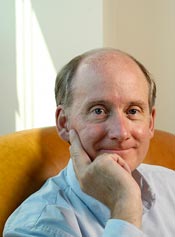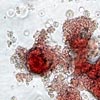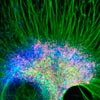Research on human embryonic stem cells marks 10-year milestone
Ten years ago today (Nov. 6, 1998), the publication in the journal Science of a short paper entitled “Embryonic Stem Cell Lines Derived from Human Blastocysts” rocked biology — and the world — as the all-purpose stem cell and its possibilities were ushered into the limelight.

Thomson
Since then, the cells have become a household word, a source of hope for the afflicted, and a boon to biologists and biology everywhere. The cells, which in nature exist for only a fleeting period before marching down different development pathways to become any of the 220 types of cells of the human body, had been shown by Wisconsin developmental biologist Jamie Thomson to be controllable in the lab dish.
The feat was hailed as a remarkable biomedical coup, a development that would one day revolutionize transplant therapy by making unlimited amounts of cells of all types available for transplant, and as a crucible for drug discovery and window to the earliest stages of human development.
In the following decade, the all-purpose cells have also become politicized and industrialized. In the laboratory, scientists have directed blank-slate stem cells to become blood cells, neurons, and beating heart cells. Stem cells and their derivatives are used in industry as high-throughput screens to test drugs for efficacy and toxicity.
On the UW–Madison campus, stem cells have inspired scores of discoveries, energized a new Stem Cell and Regenerative Medicine Center, spurred the creation of hundreds of new jobs and served as a catalyst for the development of the rising Wisconsin Institutes for Discovery.
The list of stem cell milestones in both science and society is long and diverse. Here are a few.
Nov. 6, 1998 Publication in the journal Science of the seminal paper announcing the first successful derivation and sustained culturing of human embryonic stem cells.
Sept. 14, 1999 The Wisconsin Alumni Research Foundation establishes WiCell as a clearinghouse to distribute stem cells and foster research.
Aug. 9, 2001 President Bush announces his decision to limit federal funding for embryonic stem cell research to cell lines in existence at that point in time.

Red blood cell colony derived from human embryonic stem cells.
Sept. 4, 2001 A team of Wisconsin scientists led by Dan Kaufman announces it has coaxed stem cells to become blood cells.
Nov. 30, 2001 Neural progenitor cells, stem cells that have migrated part way down the developmental pathway to becoming specific types of brain cells, are created and implanted in mice where the cells further develop into functioning neurons. The work was conducted in the laboratory of UW–Madison stem cell scientist Su-Chun Zhang at the Waisman Center.
Feb. 10, 2003 Wisconsin scientists James Thomson and Thomas Zwaka report the ability to manipulate genes in human stem cells, a technique critical to studying gene function and creating cells to mimic disease in the lab dish.
June 26, 2003 Embryonic stem cells are coaxed to become heart muscle cells by a team led by UW–Madison cardiologist Timothy Kamp.
Nov. 2, 2004 California voters approve Proposition 71, which authorizes the state to spend $3 billion over ten years on embryonic stem cell research.
Nov. 20, 2004 Wisconsin Gov. Jim Doyle announces that Wisconsin will invest up to $750 million over several years in biomedical research, including new building initiatives and direct support for research. The announcement is the catalyst for the development of the public-private Wisconsin Institutes for Discovery.

A cluster of neural cells were derived from human embryonic stem cells.
Jan. 31, 2005 Wisconsin scientist Su-Chun Zhang creates the first spinal motor neurons.
Oct. 3, 2005 The National Institutes of Health names WiCell as the nation’s first National Stem Cell Bank.
Jan. 1, 2006 WiCell researchers announce the development of stem cell culture media free of animal products, a development necessary to culture cells for therapy in humans.
May 17, 2007 UW–Madison establishes the Stem Cell and Regenerative Medicine Center.
June 20, 2007 For the second time, President Bush vetoes legislation that would expand federal funding for human embryonic stem cell research.
Nov. 20, 2007 Two teams of researchers, including a Wisconsin team led by James Thomson and Junying Yu, show that skin cells can be genetically reprogrammed to behave like embryonic stem cells.
Tags: biosciences, business, milestones, stem cells




